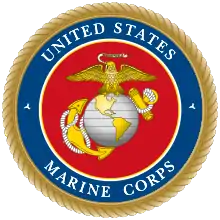Marine Aircraft Group 16
Marine Aircraft Group 16 is a United States Marine Corps aviation unit based at Marine Corps Air Station Miramar that is currently composed of five V-22 Osprey squadrons, four CH-53 Super Stallion squadrons, one Personnel Support Detachment, an aviation logistics squadron, and a wing support squadron. The group falls under the command of the 3rd Marine Aircraft Wing and the I Marine Expeditionary Force.
| Marine Aircraft Group 16 | |
|---|---|
 MAG-16's insignia | |
| Active | 1 March 1952 – present |
| Country | United States |
| Branch | USMC |
| Type | Helicopter group |
| Role | Assault support |
| Part of | 3rd Marine Aircraft Wing I Marine Expeditionary Force |
| Garrison/HQ | Marine Corps Air Station Miramar |
| Engagements | Vietnam War * Operation Starlite Operation Desert Storm Operation Enduring Freedom Operation Iraqi Freedom * 2003 Invasion of Iraq * Operation Vigilant Resolve * Operation Phantom Fury |
| Commanders | |
| Current commander | Col Eric "Flounder" Garcia |
Mission
Provide air support to Marine Air-Ground Task Force commanders.
Subordinate units
CH-53E Super Stallion Squadrons
MV-22 Osprey Squadrons
- VMM-161 "Greyhawks"
- VMM-163 "Evil Eyes (Formerly Ridge Runners)"
- VMM-165 "White Knights"
- VMM-166 "SeaElk"
- VMM-362 "Ugly Angels"
Maintenance Squadron
- MALS-16 "Forerunners"
Support Squadron
- MWSS-374 "Rhinos"
History
Marine Helicopter Transport Group 16 (MAG(HR)-16) was commissioned on March 1, 1952 at Marine Corps Air Facility Santa Ana, California.[1] MAG-16 was the first helicopter group established in the Marine Corps.[2] Prior to its activation helicopter squadrons were considered special units and reported directly to the Air Wing commanding general with no intermediate command.[2] Colonel Harold J. Mitchener was MAG-16's first commanding officer. Seven units made up the newly formed MAG: Headquarters Squadron(HQSQ) 16, Marine Airbase Squadron(MABS) 16, Marine Aircraft Maintenance Squadron(MAMS) 16, Marine Helicopter Transport Squadrons(HMR) 162, 163, 362, and 363.
Vietnam War
On the evening of 12–13 August helicopters from MAG-16 participated in the first night helicopter assault of the Vietnam War. They debarked 245 Marines and returned to Da Nang without incident.[3]
1980s & 1990s
Through the years, many other helicopter squadrons have made MAG-16 their home. Units of MAG-16 have participated in Operation Desert Punch, Operation Seahorse Wind, Operations Desert Shield/Desert Storm and many other missions, including Operation Iraqi Freedom.
MAG-16 has provided support in Somalia to include rescue operations in many other locations. MAG-16 deploys its units aboard the fleet of the United States Navy to maintain a high state of awareness overseas and abroad. MAG-16 and its units have provided aircraft support and transportation for visiting U.S. dignitaries and celebrities from the President of the United States, Secretary of Defense, Secretary of the Navy, Commandant of the Marine Corps and movie legend Audrey Hepburn. MAG-16 also provides aircraft and personnel for the MCAS Miramar Air Show.
Global War on Terror
From 11 September 2001 through to the present, elements of MAG-16 have actively participated in the Global War on Terror, beginning with HMM-163(REIN)'s role in establish FOB Rhino in Afghanistan as part of the 15th Marine Expeditionary Unit, which consisted of a core CH-46E HMM squadron, a CH-53E detachment from HMH-465, both part of MAG-16, as well as HMLA and VMA detachments. All flying squadrons of MAG-16 have participated in the GWOT in Iraq, Afghanistan, and other locations, but were almost always under the command of other headquarters elements. MAG-16's headquarters element was specifically deployed in support of the GWOT from January 2008 through January 2009, where they provided the primary command of Marine aviation support in Iraq's Al Anbar Province. By the end of this deployment in support of Operation Iraqi Freedom the MAG had achieved a milestone 80,000 flight hours in support of Multi-National Forces West and adjacent commands.[4]
Expeditionary transformation
MAG-16 continues to reshape its identity for the current expeditionary environment of the Marine Corps. The CH-46E Sea Knight is currently being replaced with the MV-22B Osprey to augment its heavy lift assault support assets. The MV-22B adds a long-range capability to the MAGTF that will extend its reach well beyond current assault support assets. MAG-16 will continue to refine its identity to "respond to today's crisis with today's force."[5]
Notable former members
- Raymond M. Clausen, Jr. - Medal of Honor recipient
- Eugene R. Brady - MAG-16 commander, Navy Cross recipient
- Robert P. Keller - Lieutenant general; served as Executive officer of the Group in 1958-1959
- Kenneth L. Reusser - Former MAG-16 commander and highly decorated three-war Marine Corps aviator, double Navy Cross and double Distinguished Flying Cross recipient.
See also
| Wikimedia Commons has media related to Marine Aircraft Group 16. |
- United States Marine Corps Aviation
- List of United States Marine Corps aircraft groups
- List of active United States Marine Corps aircraft squadrons
Citations
- Rawlins 1976, pp. 105.
- Rawlins 1976, pp. 52.
- Lehrack 2004, pp. 30.
- LCpl Dulaney, Brandon (30 January 2009). "MAG 26 assumes authority at al Asad". United States Marine Corps. Retrieved 25 February 2009.
- Representatives, House of (1 March 2011). "Statement of General James F. Amos, Commandant of the Marine Corps, Before the House Armed Services Committee on the 2011 Posture of the U.S. Marine Corps". United States Marine Corps. Retrieved 28 May 2011.
References
 This article incorporates public domain material from websites or documents of the United States Marine Corps.
This article incorporates public domain material from websites or documents of the United States Marine Corps.
- Bibliography
- Lehrack, Otto (2004). The First Battle – Operation Starlite and the Beginning of the Blood Debt in Vietnam. Havertown, Pennsylvania: Casemate. ISBN 1-932033-27-0.
- Rawlins, Eugene W. (1976). Marines and Helicopters 1946–1962. Washington, D.C.: History and Museums Division, Headquarters Marine Corps.

